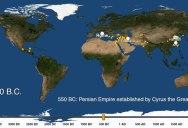The History of Urbanization from 3700 BC – 2000 AD
Statistician and data visualization expert Max Galka has created a fascinating video that shows the history of urbanization from 3700 BC – 2000 AD.
The data shown in the map comes from a Yale-led study published earlier this month in Scientific Data, which compiled the most comprehensive dataset on historical urban populations to date. Galka adds:
The researchers compiled the data from two original sources: Four Thousand Years of Urban Growth: An Historical Census by Tertius Chandler and World Cities: -3,000 to 2,000 by George Modelski. Both original sources define cities based on population, though they use different thresholds.
Chandler included only the largest cities for each time period: cities with populations over 20,000 from AD 800 to AD 1850 (excluding Asian cities which had a 40,000 population threshold for this period), and cities with populations over 40,000 after AD 1850 for all locations. Modelski used different minimum thresholds from Chandler for different eras to define a city:
Ancient (3500 BC to 1000 BC):≥10,000 inhabitants
Classical (1000 BC to AD 1000):≥100,000 inhabitants
Modern (AD 1000 onward):≥1,000,000 inhabitants
You can learn all about how Max created this visualization on his website, metrocosm.com






